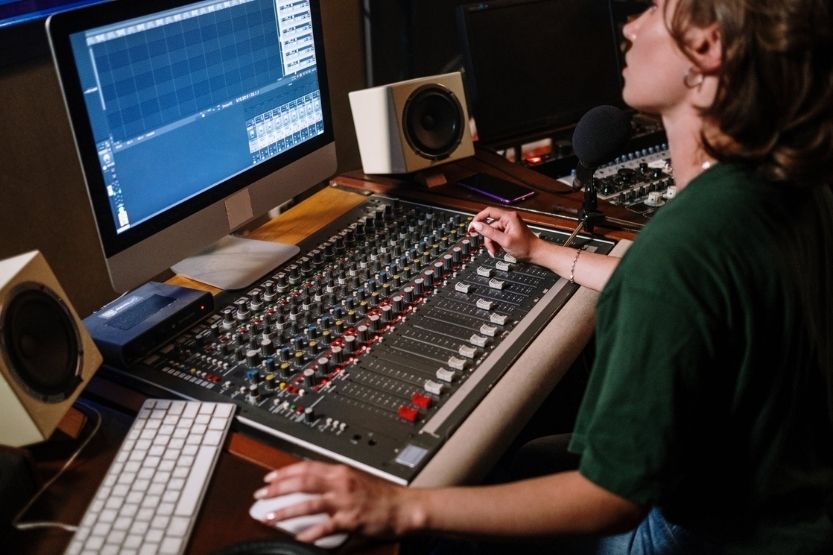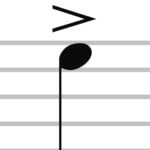In the world of music, you always hear or read about treble and bass. Even when adjusting your stereo settings, these two words typically pop up. But what is treble in music? What does treble do?
Treble in music refers to the high notes. It focuses on tones in which the range or frequency is at the higher end of human hearing. When you turn the treble up, it makes the sound more detailed or brighter.
Read on to learn more about treble in music and what it does.
What Is Treble in Music? What Does Treble Do?

In music, treble refers to the high notes. It talks about tones in which the range or frequency is at the higher end of human hearing. When you turn the treble up, it makes the sound more detailed or brighter.
What Is Treble?
If you are familiar with bass and mid-range (or middle), you are most likely familiar with treble. They are all composed of an infinite number of frequencies. In which the highest of the three is the treble.
Originated from the Latin Word “Triplum”
Treble is a term that originated from the Latin word “triplum.” It was mostly used during the 13th century to identify the third and highest range of motets.
Highest Frequency of Sound
In music, treble means the highest frequency of sound. It usually ranges between 6,000 Hz and 20,000 Hz. So, when you try to increase the sensitivity of the treble in an audio system, the sound then becomes more detailed and brighter. You will notice that the high notes are more emphasized.
What Does Treble Do?
Represented by Treble or G Clef
Treble in music consists of different variations. As for written music, it is represented by a music scripture known as the treble clef.
The treble clef is more commonly known as the G clef. It signifies the degree and pitch of notes with higher sounds. In essence, it notates musical notes above the middle C position on the stave’s second-lowest line.
Instruments That Use Treble Clef
Many musical instruments use the treble clef. These include the saxophone, guitar, trumpet, violin, and flute. In Western music notation, the treble clef is often applied since it is used for playing popular instruments.
We are most likely familiar with treble because it also appears on audio systems such as car stereos and equalizers. We are also most likely familiar with bass and mid-range in this context.
Treble Cannot Change the Song’s Overall Tone
The treble cannot change the song’s overall tone when it comes to audio systems. But it can emphasize the higher notes, making the sound clearer and brighter. In essence, if you increase the treble frequency in radio, the presenter’s voice becomes more comprehensible.
Lower Treble Frequency
More Mellow When Treble Frequency Is Low
Since you can increase the treble frequency, you can lower it too. Doing so will make the sound more mellow.
Do Not Suit All Types of Genres
Most of the time, lowered treble frequencies seem to make the music lack power. Sometimes, it makes the song sound weak. But some musicians prefer it that way or intentionally integrate it into their music style. The thing is, lowered treble frequencies do not always suit all types of genres.
Higher Treble Frequencies Can Make Song Deafening or Ear-piercing
In the same way, higher treble frequencies do not always suit all types of genres. It can make a song seem deafening or ear-piercing. Other times, it can make the music uncomfortable to listen to. That’s why the correct treble frequency must be observed at all times.
What Is the Difference Between Appoggiatura and Acciaccatura?
Treble vs Bass vs Middle

Adjusting the treble, bass, and middle settings of your car stereo allows you to boost or cut frequencies from the speaker. In essence, you change the audio settings to make them sound more pleasing to your ears.
Treble Frequencies
Treble frequencies range between 6,000 Hz and 20,000 Hz. At the same time, bass frequencies do not go higher than 150 Hz. As for the middle frequencies, they range between 200 Hz and 5,000 Hz.
Bass Allows You to Feel Pounding Bassline of the Music
While treble refers to the highest point of a frequency range, the bass is the opposite. The human voice, keyboards, and pianos can make low bass notes.
For audio systems such as the equalizer, turning up the bass will allow you to feel the pounding bassline of the music. Bass is usually emphasized in hip hop or RnB music genres.
But just like the treble frequency, the correct bass frequency must be observed at all times because there are instances when too much bass would cause walls and furniture to rattle. At times, some objects would even fall off.
Turning the Mid up Result in Emphasized Notes
In essence, treble produces overtones or smaller but faster vibrations. At the same time, the bass has ghost tones or bigger but slower vibrations. Anything between the treble and the bass is the middle, midrange, or simply mid. In audio systems, turning the mid up will result in emphasized notes in the middle sound spectrum.
Treble, Bass, and Mid Settings
The standard setting for bass, mid, and treble should be at a ratio of 4:5, regardless of the system being used. This ratio allows the treble to shine through the bass and the mid. Nonetheless, it does not overpower the bass and mid frequencies.
Again, what is treble in music? In music, treble refers to the voice with the highest pitch, or it can refer to a high-pitched or shrill sound. Treble can also refer to musical instruments with a high range.
Is Treble Better than Bass
The treble is not better than the bass, and the bass is not better than the treble either. Emphasized treble and emphasized bass will result in harsh sounds that are not pleasing to the ears.
If you want an ultimate sound tripping experience, ensure that your music has a balanced equalization.
Should Treble Be Higher than Bass
You might be wondering if the treble should be higher than the bass. The answer is yes, and there are several reasons why it should be that way. These include the following:
- Reduction of Mid Frequency Muddiness
- Balance of the Low End Rumble
- Improved Vocal Projection
1. Reduction of Mid Frequency Muddiness
One of the issues typically encountered by musicians is the muddiness present in the frequency spectrum. This usually happens when the frequency range is between 400 Hz and 800 Hz. This usually occurs when the bass is turned up too much.
This is why you can’t turn the bass higher than the treble. Boosting the bass above the treble will surely result in sound issues.
For certain instruments, the frequencies ranging from 400 Hz to 800 Hz are called the life region. This applies to instruments like the piano. You have most likely observed that this instrument’s hit or bite lies in the life region if you play the piano. Suffice to say that you should also avoid the treble to boost over the bass highly.
2. Balance of the Low End Rumble
Low-end rumble happens when your bass is turned up higher than the treble. This means that the frequencies are below 440 Hz. They result in stronger and longer frequencies in propagation through space.
Even when you are simply adjusting the settings of our audio system, it is important to balance the treble and the bass well. Often, we like to hear a lot of basses when listening to music, especially when we are on a road trip. But make sure that the bass does not overpower the treble as this will surely ruin the music.
If you are familiar with audio production software, you will also notice that less than 30 Hz feature roll is available. This role enables you to clean audio data that are less than 30 Hz. It’s basically like cleaning the sound to create a smooth listening experience. Typically, the human ear does not hear the sound below 30 Hz. But then, it is felt by vibration.
3. Improved Vocal Projection
Of course, we all know how important the vocals are when listening to a song. Typically, the vocals become muffled if you turn up the bass exaggeratedly. You find it hard to hear the lyrics, and you fail to understand the song’s message.
The frequency range for the vocals ranges between 700 Hz and 3000 Hz. This is also commonly known as the voice range. If the bass frequency is emphasized too much, it overpowers the voice region.
Suffice to say that you should not expect to hear clear vocals if you turn up the bass too much. But it is also not advisable to boost the vocals too much as this will result in a harsh sound. In fact, in music production, mixing the vocals is one of the most challenging tasks, if not the most.
Treble and Bass Settings for TV

It is best to adjust your TV’s treble and bass settings for an ultimate viewing experience. Typically, the settings for both range from 45 to 55%. The bass is usually 45%, while the treble is about 55%. This setting will result in a balanced frequency spectrum.
Does Treble Affect Bass
If you wonder whether the treble affects the bass, the answer is yes. When you turn up the treble, the vibration caused by the bass in the audio system decreases. The treble maintains the balance and makes listening to music enjoyable.
Ideal Equalizer Setting
Are you curious about the ideal equalizer setting? Typically, you can set up the equalizer so that the treble, bass, and mid knobs are in a halfway position. This is the safest setting of all. However, it does not cover all types of music genres. Also, when you are in a concert setting or on a dancefloor, you want the sounds to be more impactful.
Equalizer Setting Will Depend on Your Preference
In essence, there is no right or wrong in terms of equalizing the audio system. It depends on the music genre and your personal preference. If you are playing a hip-hop song, you want a deeper and more emphasized bass. On the contrary, if you listen to old love songs, you want a higher treble and less bass.
Type of Material the Music Bounces off Can Affect How You Adjust
It is important to note that adjusting the treble, bass, and mid also depends on the material they bounce off of. For example, the bass is typically absorbed by soft and flexible surfaces. Whereas hard and flat surfaces typically absorb the treble.
If you’re unsure how to adjust your audio settings, putting the knobs in a halfway position is always the safest option.
Conclusion – What Is Treble in Music? What Does Treble Do?
In music, treble refers to the high notes. It talks about tones in which the range or frequency is at the higher end of human hearing. When you turn the treble up, it makes the sound more detailed or brighter.
Treble makes you hear the vocals of a song better. It then allows you to understand the lyrics and enjoy everything about the music. This is what makes treble an essential part of the music.









![Read more about the article Acciaccatura and Appoggiatura Grace Notes [Guide]](https://musicalinstrumentpro.com/wp-content/uploads/2022/09/acciaccatura-and-appoggiatura-grace-notes-300x200.jpg)